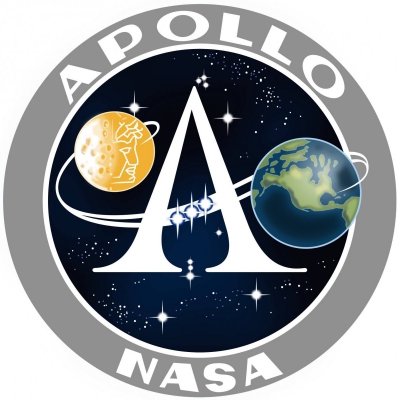Apollo 4 (November 9, 1967), also known as SA-501, was the uncrewed first test flight of the Saturn V launch vehicle, the rocket that eventually took astronauts to the Moon. The space vehicle was assembled in the Vehicle Assembly Building, and was the first to be launched from Kennedy Space Center (KSC) in Florida, ascending from Launch Complex 39, where facilities built specially for the Saturn V had been constructed.
Apollo 4 was an "all-up" test, meaning all rocket stages and spacecraft were fully functional on the initial flight, a first for NASA. It was the first time the S-IC first stage and S-II second stage flew. It also demonstrated the S-IVB third stage's first in-flight restart. The mission used a Block I command and service module modified to test several key Block II revisions, including its heat shield at simulated lunar-return velocity and angle.
The original launch date was planned for early 1967, but was delayed to November 9 because of a myriad of problems with various elements of the spacecraft, and difficulties during pre-flight testing. The need for additional inspections following the Apollo 1 fire, which killed the first Apollo crew in January 1967, also contributed to delays. These issues delayed the flight through much of 1967.
The mission splashed-down in the Pacific Ocean slightly less than nine hours after launch, having achieved its objectives. NASA considered the mission a complete success, proving that the Saturn V worked, an important step towards achieving the main objective of landing astronauts on the Moon, and bringing them back safely, before the end of the 1960s.
The Apollo program, also known as Project Apollo, was the third United States human spaceflight program carried out by the National Aeronautics and Space Administration (NASA), which succeeded in preparing and landing the first humans on the Moon from 1968 to 1972. It was first conceived during Dwight D. Eisenhower's administration as a three-person spacecraft to follow the one-person Project Mercury, which put the first Americans in space. Apollo was later dedicated to President John F. Kennedy's national goal for the 1960s of "landing a man on the Moon and returning him safely to the Earth" in an address to Congress on May 25, 1961. It was the third US human spaceflight program to fly, preceded by the two-person Project Gemini conceived in 1961 to extend spaceflight capability in support of Apollo.
Kennedy's goal was accomplished on the Apollo 11 mission when astronauts Neil Armstrong and Buzz Aldrin landed their Apollo Lunar Module (LM) on July 20, 1969, and walked on the lunar surface, while Michael Collins remained in lunar orbit in the command and service module (CSM), and all three landed safely on Earth on July 24. Five subsequent Apollo missions also landed astronauts on the Moon, the last, Apollo 17, in December 1972. In these six spaceflights, twelve people walked on the Moon.
Apollo ran from 1961 to 1972, with the first crewed flight in 1968. It encountered a major setback in 1967 when an Apollo 1 cabin fire killed the entire crew during a prelaunch test. After the first successful landing, sufficient flight hardware remained for nine follow-on landings with a plan for extended lunar geological and astrophysical exploration. Budget cuts forced the cancellation of three of these. Five of the remaining six missions achieved successful landings, but the Apollo 13 landing was prevented by an oxygen tank explosion in transit to the Moon, which destroyed the service module's capability to provide electrical power, crippling the CSM's propulsion and life support systems. The crew returned to Earth safely by using the lunar module as a "lifeboat" for these functions. Apollo used the Saturn family of rockets as launch vehicles, which were also used for an Apollo Applications Program, which consisted of Skylab, a space station that supported three crewed missions in 1973–1974, and the Apollo–Soyuz Test Project, a joint United States-Soviet Union low Earth orbit mission in 1975.
Apollo set several major human spaceflight milestones. It stands alone in sending crewed missions beyond low Earth orbit. Apollo 8 was the first crewed spacecraft to orbit another celestial body, and Apollo 11 was the first crewed spacecraft to land humans on one.
Overall the Apollo program returned 842 pounds (382 kg) of lunar rocks and soil to Earth, greatly contributing to the understanding of the Moon's composition and geological history. The program laid the foundation for NASA's subsequent human spaceflight capability, and funded construction of its Johnson Space Center and Kennedy Space Center. Apollo also spurred advances in many areas of technology incidental to rocketry and human spaceflight, including avionics, telecommunications, and computers.

1967Nov, 9
Apollo program: NASA launches the unmanned Apollo 4 test spacecraft atop the first Saturn V rocket from Cape Kennedy, Florida.
Choose Another Date
Events on 1967
- 15Jan
Green Bay Packers
The first Super Bowl is played in Los Angeles. The Green Bay Packers defeat the Kansas City Chiefs 35-10. - 28Apr
Muhammad Ali
Vietnam War: Boxer Muhammad Ali refuses his induction into the United States Army and is subsequently stripped of his championship and license. - 30May
Nigerian Civil War
The Nigerian Eastern Region declares independence as the Republic of Biafra, sparking a civil war. - 7Jun
Jerusalem
Six-Day War: Israeli soldiers enter Jerusalem. - 2Nov
Lyndon B. Johnson
Vietnam War: US President Lyndon B. Johnson and "The Wise Men" conclude that the American people should be given more optimistic reports on the progress of the war.

 English
English  español
español  français
français  português
português  русский
русский  العربية
العربية  简体中文
简体中文 